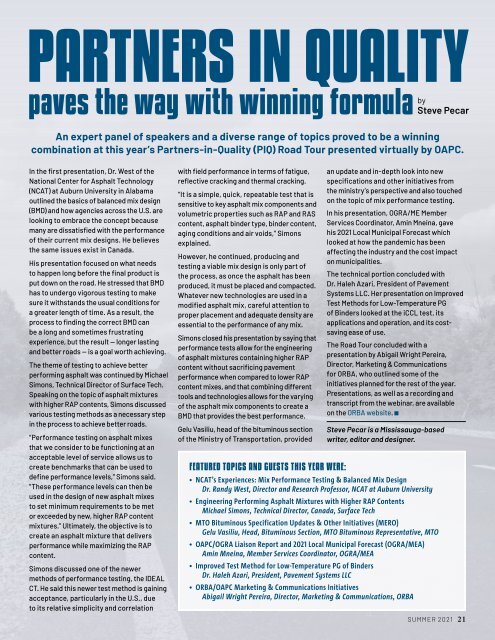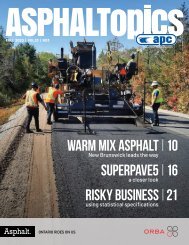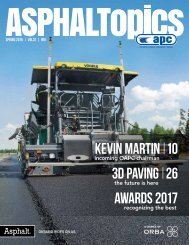ASPHALTopics | Summer 2021 | VOL 34 | NO 2
Create successful ePaper yourself
Turn your PDF publications into a flip-book with our unique Google optimized e-Paper software.
PARTNERS IN QUALITY<br />
paves the way with winning formula<br />
by<br />
Steve Pecar<br />
An expert panel of speakers and a diverse range of topics proved to be a winning<br />
combination at this year’s Partners-in-Quality (PIQ) Road Tour presented virtually by OAPC.<br />
In the first presentation, Dr. West of the<br />
National Center for Asphalt Technology<br />
(NCAT) at Auburn University in Alabama<br />
outlined the basics of balanced mix design<br />
(BMD) and how agencies across the U.S. are<br />
looking to embrace the concept because<br />
many are dissatisfied with the performance<br />
of their current mix designs. He believes<br />
the same issues exist in Canada.<br />
His presentation focused on what needs<br />
to happen long before the final product is<br />
put down on the road. He stressed that BMD<br />
has to undergo vigorous testing to make<br />
sure it withstands the usual conditions for<br />
a greater length of time. As a result, the<br />
process to finding the correct BMD can<br />
be a long and sometimes frustrating<br />
experience, but the result — longer lasting<br />
and better roads — is a goal worth achieving.<br />
The theme of testing to achieve better<br />
performing asphalt was continued by Michael<br />
Simons, Technical Director of Surface Tech.<br />
Speaking on the topic of asphalt mixtures<br />
with higher RAP contents, Simons discussed<br />
various testing methods as a necessary step<br />
in the process to achieve better roads.<br />
“Performance testing on asphalt mixes<br />
that we consider to be functioning at an<br />
acceptable level of service allows us to<br />
create benchmarks that can be used to<br />
define performance levels,” Simons said.<br />
“These performance levels can then be<br />
used in the design of new asphalt mixes<br />
to set minimum requirements to be met<br />
or exceeded by new, higher RAP content<br />
mixtures.” Ultimately, the objective is to<br />
create an asphalt mixture that delivers<br />
performance while maximizing the RAP<br />
content.<br />
Simons discussed one of the newer<br />
methods of performance testing, the IDEAL<br />
CT. He said this newer test method is gaining<br />
acceptance, particularly in the U.S., due<br />
to its relative simplicity and correlation<br />
with field performance in terms of fatigue,<br />
reflective cracking and thermal cracking.<br />
“It is a simple, quick, repeatable test that is<br />
sensitive to key asphalt mix components and<br />
volumetric properties such as RAP and RAS<br />
content, asphalt binder type, binder content,<br />
aging conditions and air voids,” Simons<br />
explained.<br />
However, he continued, producing and<br />
testing a viable mix design is only part of<br />
the process, as once the asphalt has been<br />
produced, it must be placed and compacted.<br />
Whatever new technologies are used in a<br />
modified asphalt mix, careful attention to<br />
proper placement and adequate density are<br />
essential to the performance of any mix.<br />
Simons closed his presentation by saying that<br />
performance tests allow for the engineering<br />
of asphalt mixtures containing higher RAP<br />
content without sacrificing pavement<br />
performance when compared to lower RAP<br />
content mixes, and that combining different<br />
tools and technologies allows for the varying<br />
of the asphalt mix components to create a<br />
BMD that provides the best performance.<br />
Gelu Vasiliu, head of the bituminous section<br />
of the Ministry of Transportation, provided<br />
an update and in-depth look into new<br />
specifications and other initiatives from<br />
the ministry’s perspective and also touched<br />
on the topic of mix performance testing.<br />
In his presentation, OGRA/ME Member<br />
Services Coordinator, Amin Mneina, gave<br />
his <strong>2021</strong> Local Municipal Forecast which<br />
looked at how the pandemic has been<br />
affecting the industry and the cost impact<br />
on municipalities.<br />
The technical portion concluded with<br />
Dr. Haleh Azari, President of Pavement<br />
Systems LLC. Her presentation on Improved<br />
Test Methods for Low-Temperature PG<br />
of Binders looked at the iCCL test, its<br />
applications and operation, and its costsaving<br />
ease of use.<br />
The Road Tour concluded with a<br />
presentation by Abigail Wright Pereira,<br />
Director, Marketing & Communications<br />
for ORBA, who outlined some of the<br />
initiatives planned for the rest of the year.<br />
Presentations, as well as a recording and<br />
transcript from the webinar, are available<br />
on the ORBA website.<br />
Steve Pecar is a Mississauga-based<br />
writer, editor and designer.<br />
FEATURED TOPICS AND GUESTS THIS YEAR WERE:<br />
• NCAT’s Experiences: Mix Performance Testing & Balanced Mix Design<br />
Dr. Randy West, Director and Research Professor, NCAT at Auburn University<br />
• Engineering Performing Asphalt Mixtures with Higher RAP Contents<br />
Michael Simons, Technical Director, Canada, Surface Tech<br />
• MTO Bituminous Specification Updates & Other Initiatives (MERO)<br />
Gelu Vasiliu, Head, Bituminous Section, MTO Bituminous Representative, MTO<br />
• OAPC/OGRA Liaison Report and <strong>2021</strong> Local Municipal Forecast (OGRA/MEA)<br />
Amin Mneina, Member Services Coordinator, OGRA/MEA<br />
• Improved Test Method for Low-Temperature PG of Binders<br />
Dr. Haleh Azari, President, Pavement Systems LLC<br />
• ORBA/OAPC Marketing & Communications Initiatives<br />
Abigail Wright Pereira, Director, Marketing & Communications, ORBA<br />
SUMMER <strong>2021</strong> 21

















